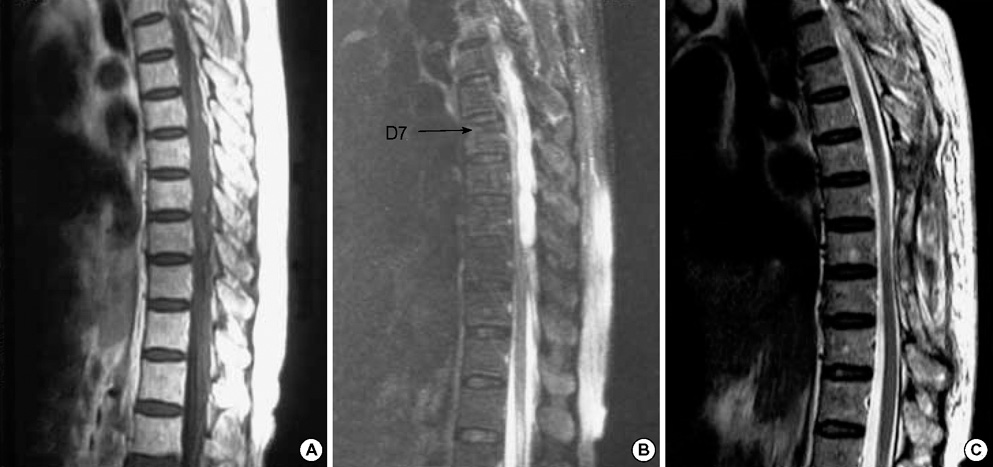J Korean Med Sci.
2007 Jun;22(3):577-579. 10.3346/jkms.2007.22.3.577.
Clopidogrel-induced Spontaneous Spinal Epidural Hematoma
- Affiliations
-
- 1Department of Neurosurgery, St. Vincent's Hospital, The Catholic University of Korea, 93-6 Ji-dong, Paldal-gu, Suwon, Korea. jaehoonsung@gmail.com
- KMID: 1778376
- DOI: http://doi.org/10.3346/jkms.2007.22.3.577
Abstract
- The hemorrhagic side effects associated with the use of clopidogrel are within the acceptable range and occur mainly at skin or gastrointestinal sites. We report a case of spontaneous spinal epidural hematoma (SSEH) in a 60-yr-old woman who was treated with clopidogrel for frequent transient ischemic attacks. To our knowledge, this is the second reported case of clopidogrel-induced SSEH. The patient's symptoms and past history of clopidogrel use suggested the diagnosis and made the procedure proceed quickly to operate SSEH 9 hr after the onset of paraplegia. The outcome was excellent. Therefore, with the popularity of antiplatelet prescription, physicians should keep in mind and urgently treat this unusual but critical side effect.
MeSH Terms
Figure
Cited by 2 articles
-
Clinical Outcomes of Spontaneous Spinal Epidural Hematoma : A Comparative Study between Conservative and Surgical Treatment
Tackeun Kim, Chang-Hyun Lee, Seung-Jae Hyun, Sang Hoon Yoon, Ki-Jeong Kim, Hyun-Jib Kim
J Korean Neurosurg Soc. 2012;52(6):523-527. doi: 10.3340/jkns.2012.52.6.523.Spinal Subarachnoid Hematoma as a Complication of an Intramuscular Stimulation : Case Report and a Review of Literatures
Myeong Jong Lee, Young Sun Chung
J Korean Neurosurg Soc. 2013;54(1):58-60. doi: 10.3340/jkns.2013.54.1.58.
Reference
-
1. Liao CC, Lee ST, Hsu WC, Chen LR, Lui TN, Lee SC. Experience in the surgical management of spontaneous spinal epidural hematoma. J Neurosurg Spine. 2004. 100:38–45.
Article2. Heye N. Is there a link between acute spinal epidural hematoma and aspirin? Spine. 1995. 20:1931–1932.
Article3. Mishima K, Aritake K, Morita A, Miyagawa N, Segawa H, Sano K. A case of acute spinal epidural hematoma in a patient with antiplatelet therapy. No Shinkei Geka. 1989. 17:849–853.4. Wagner S, Forsting M, Hacke W. Spontaneous resolution of a large spinal epidural hematoma: case report. Neurosurgery. 1996. 38:816–818.
Article5. Weber J, Hoch A, Kilisek L, Spring A. Spontaneous intraspinal epidural hematoma secondary to use of platelet aggregation inhibitors. Dtsch Med Wochenschr. 2001. 126:876–878.6. Seet RC, Lim EC, Wilder-Smith EP, Ong BK. Spontaneous epidural hematoma presenting as cord compression in a patient receiving clopidogrel. Eur J Neurol. 2005. 12:811–812.7. Antiplatelet Trialists' Collaboration. Collaborative overview of randomised trials of antiplatelet therapy. I: prevention of death, myocardial infarction, and stroke by prolonged antiplatelet therapy in various categories of patients. BMJ. 1994. 308:81–106.8. Bhatt DL, Topol EJ. Scientific and therapeutic advances in antiplatelet therapy. Nat Rev Drug Discov. 2003. 2:15–28.
Article9. CAPRIE Steering Committee. A randomised, blinded, trial for clopidogrel versus aspirin in patients at risk of ischemic event (CAPRIE). Lancet. 1996. 348:1329–1339.10. Uber-Zak LD, Venkatesh YS. Neurologic complications of sit-ups associated with the Valsalva maneuver: 2 case reports. Arch Phys Med Rehabil. 2002. 83:278–282.
Article11. Ferrante A, Pedi C, Centamore G, Di Stefano G, Nicotra S, Privitera A, Malfitano D, Cristaudo C, Tomarchio L. A rare complication of thrombolytic therapy: spinal epidural hematoma. A case report. Ital Heart J. 2003. 4:688–690.12. Litz RJ, Gottschlich B, Stehr SN. Spinal epidural hematoma after spinal anesthesia in a patient treated with clopidogrel and enoxaparin. Anesthesiology. 2004. 101:1467–1470.
Article13. Horcajadas A, Katati M, Arraez MA, Ros B, Abdullah O, Castaneda M, de la Linde C. Spontaneous epidural spinal hematoma: Report of 2 cases and review of literature. Neurologia. 1998. 13:401–404.14. Major O, Sipos L, Czirjak S, Benoist G, Horvath M, Pasztor E. Spontaneous spinal epidural haematomas. Acta Neurochi (Wien). 1991. 111:40–42.
Article15. Kirazli Y, Akkoc Y, Kanyilmaz S. Spinal epidural hematoma associated with oral anticoagulation therapy. Am J Phys Med Rehabil. 2004. 83:220–223.
Article16. Lonjon MM, Paquis P, Chanalet S, Grellier P. Nontraumatic spinal epidural hematoma: report of four cases and review of the literature. Neurosurgery. 1997. 41:483–486.
Article17. Song KJ, Lee KB. The poor outcome of the delayed diagnosis of acute spontaneous spinal epidural hematoma: two cases report. J Korean Med Sci. 2005. 20:331–334.18. Groen RJ, van Alphen HA. Operative treatment of spontaneous spinal epidural hematomas: a study of the factors determining postoperative outcome. Neurosurgery. 1996. 39:494–508.
Article



